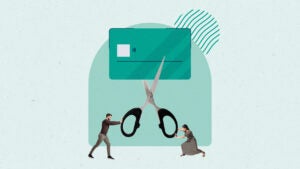Living debt free and how to get there




Living debt-free might sound like a dream, but it’s a goal that’s entirely within your reach. Imagine the freedom of not stressing over credit card balances, loan payments or overdue bills. No more juggling due dates or feeling the weight of interest piling up. Instead, you could use your hard-earned money for things that truly matter — saving for your future, enjoying experiences or simply having peace of mind. It starts with a mindset shift and a plan tailored to your financial situation.
In this guide, we’ll walk you through the steps to take control of your finances and get rid of debt. From creating a budget that works for you to tackling your debts one by one, you’ll discover practical strategies that make the process manageable — even empowering. Whether you’re drowning in bills or just looking to fine-tune your money habits, this is your roadmap to a debt-free life and the financial freedom you’ve been dreaming about.
- In the third quarter of 2024, Americans collectively held a substantial $17.94 trillion in debt. Credit card balances rose by $24 billion over the previous quarter.
- The typical American household owes more than $105,000 in debt, including student loans, credit cards, mortgages, auto loans and other forms of credit.
- More than half of U.S. adults (52 percent) say that financial concerns negatively impact their mental health.
- 21 percent of Americans have identified paying down debt as their primary financial goal for 2025.
What does it mean to be debt-free?
Being debt-free means you no longer owe money to creditors — no lingering credit card balances, car loans, student loans or other forms of debt weighing you down. It’s not just about having a zero balance: it’s about financial freedom.
When you’re debt-free, your income is yours to save, spend and invest as you see fit. It means you’re not tied to monthly payments or the stress of high interest rates, and you can build a safety net for emergencies or plan for future goals. Living without debt creates a sense of security and empowerment, giving you the freedom to make choices without financial constraints holding you back.
Is it better to live without debt?
Living without debt can offer immense benefits, but whether it’s “better” depends on your goals and financial situation.
Being debt-free means you’re not tied to monthly payments or accumulating interest, which can free up your income for savings, investments and experiences that bring you joy. It reduces financial stress and provides security, knowing you’re not relying on borrowed money to meet your needs. For many, the freedom to make choices without the constraints of debt is a significant step toward long-term financial stability and independence.
However, not all debts are created equal, and some forms can be useful when managed wisely. For example, a mortgage can help you invest in a home, and student loans can provide access to education that increases earning potential.
The key is to avoid high-interest consumer debt, such as credit cards, and to use other forms of debt strategically and sparingly. Ultimately, living without debt is often the ideal scenario, but the real goal is achieving financial balance — using money as a tool to enhance your life, not control it.
How to live debt-free ASAP
If you’re determined to break free from debt, you must tailor a strategic plan for your financial situation. Here’s a comprehensive roadmap that shows how to live debt-free.
1. Evaluate your debt
Start by reviewing all your outstanding accounts closely to understand your situation. You’ll want to know the total amount you owe with interest and how long it will take to pay off your debts.
Pull a copy of your credit report. You can get free weekly credit reports from the three major credit bureaus through AnnualCreditReport.com.
Compile a list of all accounts with outstanding balances, including:
- Credit cards
- Loans
- Mortgages
- Any other debts you owe, including those that might not be on your credit report such as what you owe family and friends
Write down the interest rate and minimum monthly payment associated with each debt. Your account servicer will have this information if it isn’t listed on your monthly statements.
Calculate the time it will take to pay off each account and the total amount you will pay with interest if you make only the minimum payments. For accurate insights, use a credit card payoff calculator for revolving accounts and an amortization calculator for mortgages and other accounts with fixed terms. Your lender should also be able to provide an estimated payoff date for fixed-term loans and mortgages.
Here’s what this list might look like:
|
Account |
Amount owed |
Interest rate |
Minimum payment |
Estimated payoff date |
Total cost with interest |
|
Mortgage |
$260,000 |
3% |
$1,096 |
April 2054 |
$394,621 |
|
Auto loan |
$11,000 |
10% |
$145 |
April 2034 |
$17,444 |
|
Student loan |
$19,000 |
2.75% |
$129 |
April 2039 |
$23,209 |
|
Credit card |
$4,500 |
17% |
$90 |
April 2031 |
$7,883 |
Looking closely at your total debt can help you prioritize and motivate you to stick to your payoff plan.
2. Choose a payoff strategy
It’s essential to pick a debt repayment strategy that fits your financial situation and keeps you motivated.
For instance, the debt snowball method focuses on paying off your smallest debts first while making minimum payments on the rest. As you pay off each small debt, you gain momentum and confidence to tackle larger balances. This method is excellent for those who like quick wins to help them stay motivated. Alternatively, the debt avalanche method prioritizes paying off debts with the highest interest rates first. This approach saves you the most money over time by reducing the amount you pay in interest.
Both methods work if you stay consistent, so choose the one that aligns with your personality and goals. Whichever strategy you select, automate your payments where possible to ensure you stay on track and avoid missing due dates.
|
Aspect |
Debt Snowball |
Debt Avalanche |
|
Strategy |
Pay off debts from smallest to largest balance regardless of interest rate. |
Pay off debts with the highest interest rate first, regardless of balance size. |
|
Psychological Impact |
Provides quick wins by tackling smaller debts first, which can boost motivation. |
Focuses on minimizing overall interest costs, which may take longer to see significant progress. |
|
Interest Savings |
May result in paying more interest overall, especially if higher interest rate debts are larger. |
Typically saves more money on interest over time by targeting high-interest debts first. |
|
Debt Payoff Time |
Can lead to quicker payoff of individual debts, providing a sense of accomplishment. |
May take longer to pay off the first debt due to focusing on high-interest balances first. |
|
Suitability |
Ideal for individuals who value quick wins and motivation, even if it means paying more interest overall. |
Suitable for those focused on minimizing interest costs and are disciplined enough to stick with the method despite potentially slower initial progress. |
3. Revamp your budget
A budget is your most powerful tool for getting rid of debt. Start by tracking your income and expenses to understand where your money is going each month. Break your spending into categories like housing, groceries, transportation, entertainment and discretionary expenses. Bankrate’s home budget calculator can help you get started.
Once you’ve identified your spending habits, look for areas where you can cut back. Can you cook at home more often? Cancel unused subscriptions? Delay non-essential purchases? Every dollar saved is a dollar that can go toward your debt.
As you create your budget, make paying off debt a priority. Designate a specific amount each month to put toward extra payments on your highest-priority debts. Treat this as a non-negotiable expense, just like rent or utilities. Sticking to a disciplined budget may require temporary sacrifices, but the long-term reward of financial freedom is worth it.
4. Develop positive money habits
Consistency is the key to living debt-free. Commit to making your payments on time every month and stick to your repayment strategy. It can be tempting to deviate from your plan or spend on non-essentials, but staying disciplined is crucial.
Build an emergency fund with at least $500 to $1,000 to cover unexpected expenses and avoid falling back on credit cards. Celebrate small milestones like paying off a specific debt or reaching a savings goal to keep your morale high.
Most importantly, avoid taking on new debt while working to become debt-free. If you must use credit, pay the balance in full each month to avoid interest charges. Adopt habits that support long-term financial health, such as tracking your spending and setting goals for saving and investing.
Good debt vs. bad debt
Understanding the difference between good and bad debt helps you make informed choices about borrowing, ensuring that any debt you take on serves your goals and improves your financial well-being.
Good debt
- Invests in your future: Good debt is typically used to finance opportunities that have the potential to increase your wealth or improve your quality of life over time. Examples include student loans for higher education or a mortgage to purchase a home.
- Lower interest rates: It usually comes with relatively low and manageable interest rates, making it more affordable to pay off over time.
- Long-term value: The asset or opportunity generally appreciates in value or contributes to your earning potential.
- Purpose-driven: This type of debt is intentional and focused on achieving specific, meaningful goals, such as starting a business or advancing your career.
Bad debt
- Decreases financial security: Bad debt can lead to a cycle of borrowing, where interest and fees accumulate faster than you can pay them off, eroding your financial stability.
- Finances non-essentials: Bad debt is often used to pay for items or experiences that don’t hold their value or generate future returns, such as luxury goods, vacations or dining out.
- High interest rates: It typically comes with steep interest rates, as seen with credit cards, payday loans or certain personal loans, making it harder to pay off quickly.
- Impulsive or unnecessary: This kind of debt often results from impulse purchases or lack of planning, leading to regret and financial strain.
Next steps
Living debt-free is about more than just paying off your balances — it’s about making your money work for you. The journey might require discipline and temporary sacrifices, but the payoff is worth it: freedom from financial stress and the ability to focus on your goals and dreams.
Now it’s time to take action. Start by listing your debts, setting a budget and choosing a repayment strategy that suits your needs. Commit to avoiding new debt and explore ways to increase your income to speed up the process. Celebrate your progress along the way and don’t be afraid to seek help if you need it — whether from financial advisors, debt counselors or trusted friends and family.
The path to a debt-free life is a journey, but every step you take brings you closer to the peace of mind and financial freedom you deserve.




